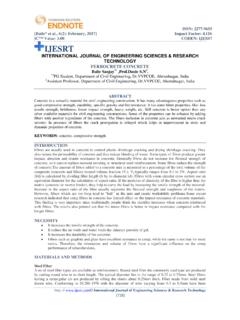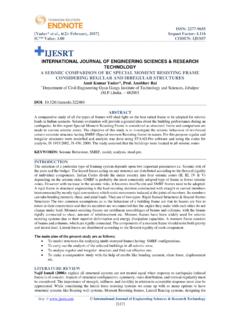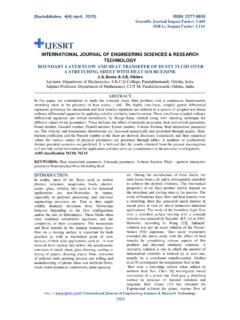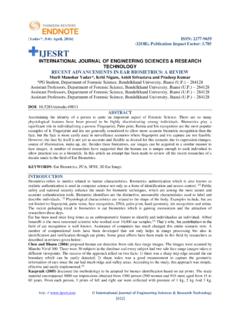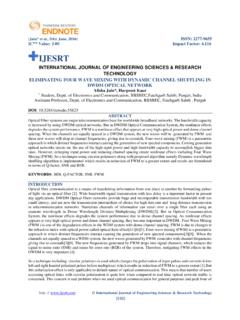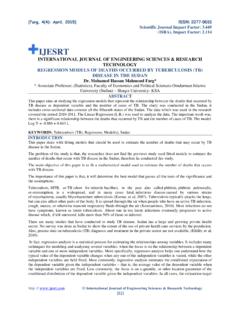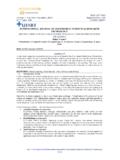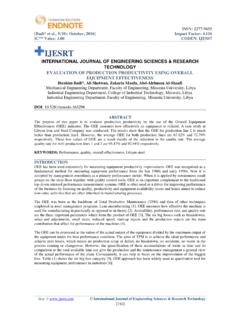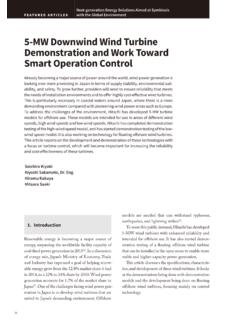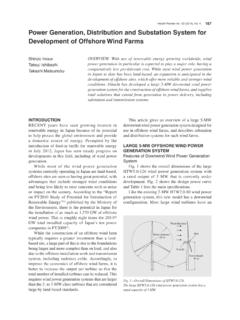Transcription of IJESRT
1 [Jobeena, 4(5): May, 2015] ISSN: 2277-9655 (I2OR), Publication Impact Factor: (ISRA), Impact Factor: http: // International Journal of Engineering Sciences & Research Technology [467] IJESRT INTERNATIONAL JOURNAL OF ENGINEERING SCIENCES & RESEARCH TECHNOLOGY SCOPE FOR THE IMPLEMENTATION OF INTEGRATED ROOF WIND ENERGY SYSTEM IN INDIA: AN OVERVIEW Jobeena *,Savinth Kumar *PG Student,Assistant professor, *Department of Structural Engineering, CSI College of Engineering,TheNilgiris, Tamilnadu, India. Department of Structural Engineering, CSI College of Engineering, TheNilgiris, Tamilnadu, India. ABSTRACT Wind is a non-polluting and renewable source of energy. Wind energy is the fastest growing source of renewable energy in the world.
2 It has an average growth rate of 30%. In terms of wind wind energy production, after USA, Germany, Spain, and China, India occupies the fifth place in the world. There are many issues concerned in the distribution of energy to the definite location where larger scale productions are concerned therefore cost effective solutions have been found at smaller scale . The Integrated Roof Wind Energy System is considered to overcome the existing issues of urban and larger scale renewable energy system. The system is built by using skewed shaped funnels set in an axial array and its function involves acceleration of the wind flow by making use of the Venturi Effect. This leads to a converging air capturing inlet which is carefully designed with innovative shape and geometry to create high wind mass flow and velocity toward a vertical-axis wind turbine on roof top for comparatively high amount energy generation.
3 This review presents an overview of the challenges to large scale wind power development in India and the scope for introducing Intergrated Roof Wind Energy System (IRWES). KEYWORDS: Integrated Roof Wind Energy System ,venturi-effect, louvers, Vertical Axis Wind Turbine INTRODUCTION A promising renewable energy policy development has become a mission among the world wide researchers and governors due to rise in prices for fossil fuels, an increase in energy consumption, and electricity, global climate change,environmental disasters, etc.[9].Wind energy generation is an inexhaustible resource availability and is considered as the most attractive technology, while considering the ecological value and economical prospects. It has the potential to moderate the cost of electricity, to scale down the emissions of CO2 from power industries and decrease the reliance on costly fossil fuels.
4 Twenty two countries have more than 1,000 MW installed capacity. This development was led by the China, US, Germany, Spain and India, and it brought global cumulative installed capacity to 2,82,482 MW (as of 30 June 2012). The top five countries in terms of cumulative installed capacity are China (75,564 MW), the US (60,007 MW), Germany (31,332 MW), Spain (22,796 MW) and India (18,421 MW) [3]. BP Global has estimated that World proven oil reserves in 2010 are sufficient to meet years of the global production [23]. MATERIALS AND METHODS Wind energy in India About 53% of electric power in India is generated from coal and lignite based steam thermal plants, which contribute a lot to air pollution. The need of the hour is a cleaner and renewable source of energy, in which off shore wind power can play a major role. India is one of the five largest wind energy markets in the world today.
5 Renewable energy sources (excluding large hydro) represent of India s installed capacity, with 70% of this contribution coming from wind energy [13]. India is blessed with a coastline of about 7,600 km. Under a national wind monitoring programme, winds have been measured at 54 locations on the coastline In Wind Chronicle, 2008/09. The onshore wind power potential for India has been estimated as 15000 MW (<60 m depth). There are many potential sites in Indian waters and still this huge potential remains untapped (Awesome Inc.,2011).The western coastline has modest potential at sea level. The southern tip of India starting from Kanyakumari up to Rameshwaram has shown some promising values. Rameshwaram indicates windpower density of 603 Wm-2 at 50 m agl and Kanyakumari has shown [Jobeena, 4(5): May, 2015] ISSN: 2277-9655 (I2OR), Publication Impact Factor: (ISRA), Impact Factor: http: // International Journal of Engineering Sciences & Research Technology [468] wind power density in the range of 370 Wm-2 at 30 m agl [8].
6 Studies on wind energy development shows that more than 95 percent of the nation s wind energy development today is concentrated in just five states in western and southern India Tamil Nadu, Andhra Pradesh, Karnataka, Maharashtra, and Gujarat (LBNL, 2012). These five states accounted for over 85% of the total installed capacity at the end of the last plan period [14]. Srinivasa Rao Kasisomayajula [6] listed the State-wise Wind Power Generation and installed capacity in India up to 31st March 2010 (Tamil MW, MW, MW, MW, MW, Madhya , MW and West ). Issues related to large scale wind energy production From the analysis performed by IRENA [20], it was observed that the health of India s wind energy sector gives importance to the issues of grid integration, forecasting and scheduling.
7 There are many problems within the power sector in India and the main problem include the reliability and structural inefficiencies which causes sustained wind power growth poses a challenging environment for the wind power. India being a country largely dependent on tax incentives invites only a mere range of private investors for wind power policy in a reliable energy source has to be ensured in India then there is a need for India to move to a higher trajectory growth as energy is vital for wind sector growth. The power supply position prevailing in India has high prices for industrial consumers and is characterized by unreliability and persistent shortages hence energy scenario in India is not satisfactory [15]. The wind turbine installation and manufacturing requires heavy upfront investments. Wind turbines can be a threat to wildlife in the case of birds and bats having been killed as they tend to fall into the rotors.
8 Noise is regularly reported as a problem by neighboring homes. Even if private lands are available but the supply and transport issues poses problems and the conversion of land use status from agricultural to nonagricultural is a time consuming process. Further if the land is close to a protected area or forestlandsthen obtaining clearance from forest authorities for using the forestland for wind power generation is time consuming [14]. The constraints to large scae wind energy production involves the location of turbines in the remote areas of the country thus the distribution and transmission to the other parts of India lacks draw back persisting is the variability of wind power which can create problems for the traditional grids in maintaining a supply and demand developers are building fewer wind farms in comparison to 2011 and a transition-phase was seen after government incentives saw significant reductions post March 2012 [22].
9 Due to the various issues that need concern at large scale level the need for the hour is the wind energy at the residential level. Description of Intergrated Wind Energy System The concept of the Integrated Roof Wind Energy System (IRWES) was initially designed by Suma in 2009[2]; to harvest winds from any direction. According to Suma et al. [2] the IRWES introduces a novel implementation of the Venturi principle [1] into a residential roof structure or as top-up high-rise roof unit.[ ].The studies made by Ferraro et al [11], showed the lower partof the roof has dual-purpose openings which serveas the inlets to capture incoming air flow andoutlets for the outgoing air flow when the wind comes from opposite direction. Figure 1: Cross-section of flat-shaped roof with idealized incoming flow [Jobeena, 4(5): May, 2015] ISSN: 2277-9655 (I2OR), Publication Impact Factor: (ISRA), Impact Factor: http: // International Journal of Engineering Sciences & Research Technology [469] The incoming windflow passes through a number of radiallydistributed inlet guide ducts, and is accelerated by their skewed shape to strike the VAWT located atthe top of the roof.
10 The shape, dimension, and position of thelouvers create higher wind capturing. In addition, louvers at the funnel entrances direct the fa ade interacting wind flow into the funnel system: increasing the capturing area, total mass flow rate, and prevent vertical outflow along the line of the roof. The louvers also take care of adjusting the incoming wind speed or completely seal the entrance during events of extreme weather the leeward side, a low pressure vertical base flow is formed behind the wall and beneath the roof shape. The leeward region has relative lower pressure and creates a suction effect which facilitates the exit of flow through outlets[11]. Figure 2: Exploded view of IRWES From the Investigations of Suma et al. [12],it was observed that IRWES introduced more advantages over conventional VAWT systems and has the potential to meet or exceed the efficiency level of a HAWT.
